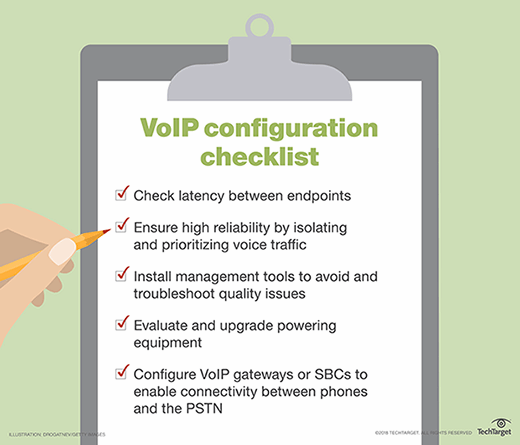
backgroundstore - Fotolia
How to configure VoIP on a network
VoIP configuration requires significant preplanning to meet the requirements of voice traffic. Learn the steps to take when configuring VoIP on your network.
Troubleshooting poor voice performance can be problematic if packets are taking multiple paths across your network. If VoIP doesn't work, it will likely negatively affect business and create security issues, as workers may be unable to call for help in an emergency.
VoIP configuration requires preplanning to ensure you have minimal latency between endpoints, a high level of reliability, and proper management tools to ensure you can proactively and reactively mitigate quality-related issues.
To configure VoIP in an existing network, you must also address how phones receive power. In a time-division multiplexing environment, the PBX provides power to phones over copper wiring. With VoIP, phones require a new source of power, typically via Ethernet networks using Power over Ethernet (PoE).
Phones may also be plugged into wall jacks, meaning you'll have to address backup electrical power as part of your resiliency strategy. Adding PoE support to existing Ethernet switches may require upgrading wiring, cooling systems in wiring closets and a strategy for providing resiliency in the event of a power outage.
VoIP configuration using virtual LANs (VLANs) isolates voice traffic from the rest of your network. Using VLANs enables network administrators to assign appropriate prioritization and security controls for voice traffic. Phones can be manually assigned into VLANs, or you can use protocols like Link Layer Discovery Protocol or Cisco Discovery Protocol to allow Ethernet switches to automatically identify phones and properly configure their IP address and virtual LAN.
As part of your VoIP configuration, you will need to account for each phone having its own IP address, typically assigned via Dynamic Host Configuration Protocol. When using private IP addresses, you will need to configure VoIP gateways or session border controllers capable of enabling connectivity between your internal phones and the PSTN.

Increasingly, organizations are moving away from desktop phones to softphone clients running on PCs, laptops and mobile devices. To configure VoIP softphones, your network requires that your wireless LAN access points are capable of prioritizing voice traffic and have sufficient wireless coverage to avoid dead spots and congestion.
You should also provision high-quality headsets to ensure voice quality and have visibility into softphone performance to quickly isolate and troubleshoot performance-related issues. Generally, when using softphones, you lose the ability to isolate voice traffic into its own VLAN, so your network must be able to recognize voice packets and prioritize them appropriately, even when encrypted.
Do you have a question for Irwin Lazar or any other experts? Ask your enterprise-specific questions today! All questions are treated anonymously.







